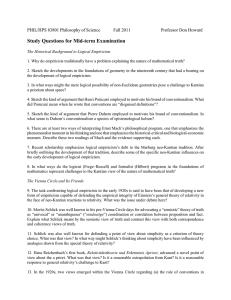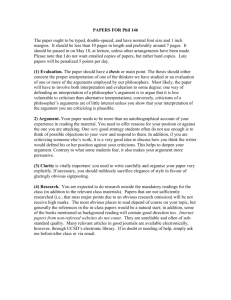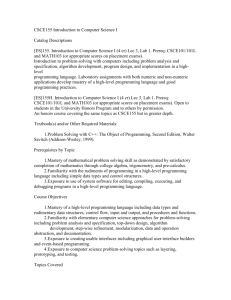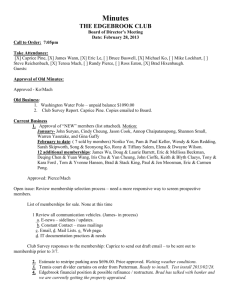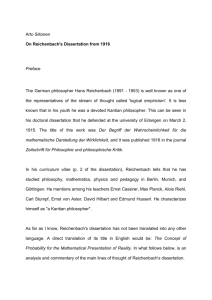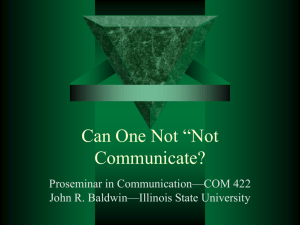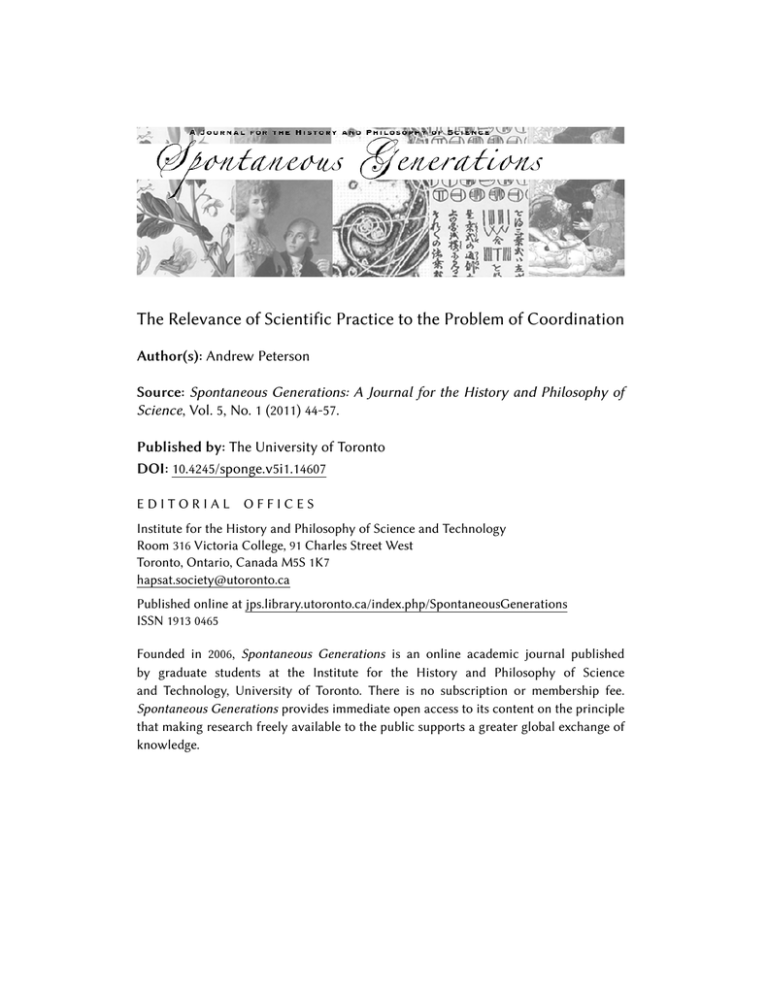
The Relevance of Scientific Practice to the Problem of Coordination
Author(s): Andrew Peterson
Source: Spontaneous Generations: A Journal for the History and Philosophy of
Science, Vol. 5, No. 1 (2011) 44-57.
Published by: The University of Toronto
DOI: 10.4245/sponge.v5i1.14607
EDITORIAL
OFFICES
Institute for the History and Philosophy of Science and Technology
Room 316 Victoria College, 91 Charles Street West
Toronto, Ontario, Canada M5S 1K7
hapsat.society@utoronto.ca
Published online at jps.library.utoronto.ca/index.php/SpontaneousGenerations
ISSN 1913 0465
Founded in 2006, Spontaneous Generations is an online academic journal published
by graduate students at the Institute for the History and Philosophy of Science
and Technology, University of Toronto. There is no subscription or membership fee.
Spontaneous Generations provides immediate open access to its content on the principle
that making research freely available to the public supports a greater global exchange of
knowledge.
PR
The Relevance of Scientific Practice to The
Problem of Coordination∗,†
Andrew Peterson‡
In his early work on the problem of coordination, Hans Reichenbach
introduced axioms of coordination to describe the relationship between
theory and observation. His insistence that these axioms are determinable
a priori, however, causes him to ignore the normative dimensions of
scientific inquiry and, in turn, generates a misleading interpretation of
the theory-observation relationship. In response, I propose an alternative
approach that describes this relationship through the framework of
scientific practices. My argument will draw on two examples that
have not been explored by the philosophical literature in the context
of coordination problems: the clinical definition of death and Stanley
Prusiner’s prion hypothesis.
I. T P W R’ S T P
C
In his early discussion of the relationship between geometry and physics, Hans
Reichenbach introduced axioms of coordination to describe the linkage between
scientific theory and concrete observation. In his mind, the highly abstract
expressions of theory were clearly distinguishable from the physical observations
they came to describe, yet the means by which they became related remained
entirely unclear. Responding to Kant’s synthetic a priori and in an effort to
understand the philosophical foundations of relativity theory, Reichenbach argued
that theory and observation are linked through axioms of coordination stipulated
by the scientist prior to empirical application. Such axioms were believed to
establish the a priori grounds upon which the use of a theoretical expression
became empirically meaningful. The theoretical expression, “the meter,” for
example, becomes empirically meaningful only aer its a priori coordination to
a physical object in Paris has been established (Reichenbach 1958, 14-15).
∗
†
‡
I am greatly appreciative of the valuable comments provided by Isabelle Peschard, Bas van
Fraassen, Kris Kemtrup, and Tyrus Fisher on multiple dras of this paper.
Received 7 December 2010. Accepted 28 July 2011.
Andrew Peterson’s work focuses on the philosophy of medical science and bioethics in clinical
and research seings. He has special interest in neurological conditions and reintegration
challenges faced by combat veterans. Andrew Peterson received his MA from San Francisco
State University, is a PhD candidate at The University of Western Ontario, and is a member of
the Rotman Institute of Philosophy.
Spontaneous Generations 5:1 (2011) ISSN 1913-0465. University of Toronto.
Copyright 2011 by the HAPSAT Society. Some rights reserved.
44
A. Peterson
The Relevance of Scientific Practice
Contrary to Reichenbach’s position, I argue that the interpretive framework
of axioms of coordination obscures the importance of scientific practices in
the coordination process. Through his insistence that coordinative axioms
are determinable a priori, Reichenbach presumes that the theory-observation
relationship is initially intelligible independent of the concrete scientific practices
that constitute the involved, experiential aspects of scientific inquiry. On my view,
the linkage between theory and observation is not determinable a priori. Rather,
this linkage is contingent upon the normative constraints that emerge from the
involved, practical activities of a scientific culture.
To defend this claim, I exhibit the deficiencies of Reichenbach’s position by
applying it broadly to two examples previously unexplored by the philosophical
literature in the context of coordination problems. First, I explore the clinical
definition of death and its coordination to physical signs manifested in a patient’s
body. I show that Reichenbach’s position does not account for the legal norms
that constrain such medical diagnoses in practice. I then turn to a second example,
Stanley Prusiner’s prion hypothesis, to defend Reichenbach’s position by removing
the normative dimension of coordination in the case study. I show, however, that
despite such an alteration to the example, the prion hypothesis is also contingent
upon social norms and a value-laden experimental culture. On the basis of these
criticisms, I argue that axioms of coordination are insufficient for explaining the
relationship between theory and observation when science is understood in terms
of its practices.
II. R’ A P A C.
Beginning as early as his 1915 doctoral dissertation, Reichenbach devoted
himself to answering the following question: how do the objects of knowledge in
mathematics link up with the objects of knowledge in physics? (cf. Reichenbach
1965, 34) The epistemic strength of mathematical theorems is determined by
internal coherence, yet “the truth of physical propositions…depends on relations
to something external” (Reichenbach 1965, 34). In light of this, he considered
how concrete observations correlate with a theoretical expression such as
PV=rT. Though the theoretical expression is logically coherent in and of itself,
its connection to the empirical manifestations of “pressure,” “volume,” and
“temperature” is altogether vague. “What is lacking,” Reichenbach claimed,
“is…the assertion that the system of equations is true for reality” (Reichenbach
1965, 36).
A priori axioms of coordination were introduced as the key for clarifying this
vague relationship. As previously described, a theoretical expression such as “the
meter” is coordinated with the physical object in Paris in an effort to render a
theory that is empirically meaningful prior to application in physical measurement
(cf. Reichenbach 1958, 14-15). Another example discussed by Reichenbach involved
the coordination of geometric concepts to the physical manifestation of the earth.
Spontaneous Generations 5:1(2011)
45
A. Peterson
The Relevance of Scientific Practice
“By calling the earth a sphere, we are coordinating the mathematical figure of a
sphere to certain visual and tactile perceptions that we call ‘perceptual images
of the earth’” (Reichenbach 1965, 37). These axioms of coordination, stipulated
prior to experience, not only establish a correlation between seemingly discrete
components of scientific inquiry—theory and observation—they also establish the
grounds for believing that abstract theory is expressing something of empirical
importance.
Reichenbach observed, however, that the correlation these coordinations
provide is far more “peculiar” than such simple examples might lead us to believe
(Reichenbach 1965, 37). Unlike internal coordinations amongst mathematical
equations, the definition of theoretical sets in relation to an observational side of
the coordination is intrinsically problematic. Reichenbach described the problem
in the following way:
For example, if two sets of points are given, we establish a
correspondence between them by coordinating to every point of one
set a point of the other set. For this purpose, the elements of each
set must be defined; that is, for each set there must exist another
definition in addition to that which determines the co-ordination to
the other set. (Reichenbach 1965, 37)
But, as Reichenbach observed, “such definitions are lacking on the side of the
coordination dealing with the cognition of reality” (Reichenbach 1965, 37). In
response to this paradox, Reichenbach argues: “although the equations, that is,
the conceptual side of the coordination, are uniquely defined, the ‘real’ is not.
On the contrary, the ‘real,’ is defined by the coordinations to the equations”
(Reichenbach 1965, 37-38). In effect, the observational side of the coordination is
initially subsumed under the defining power of the theory as established through
the axioms. The perceivable object in Paris, in other words, is defined by its
coordination to the mathematic theory expressed through the term “the meter”
and not the other way around.
Anticipating the criticism that this description undermines the importance of
the observable side of the coordination, Reichenbach added, “although there is a
coordination to undefined elements, it is restricted, not arbitrary” (Reichenbach
1965, 42). This restriction is imparted by observable correlates derived from reality.
Though perception does not supply the definition of what is real (cf. Reichenbach
1965, 42), the physical side of the coordination constrains the scope of concepts
intelligibly coordinated with it. If this were not the case, one could easily presume
that any set of physical correlates is “fictitious, a hypothesized thing-in-itself”
(Reichenbach 1965, 42).
In the overall context of Reichenbach’s description of a priori axioms, this
“mutuality of coordination” (Reichenbach 1965, 42) is perhaps the most puzzling.
Throughout he insisted that the axioms of coordination are determinable prior
Spontaneous Generations 5:1(2011)
46
A. Peterson
The Relevance of Scientific Practice
to experience, yet the claim that both sides of the coordination are mutual
leads one to believe the coordinated relationship is far more complex. Moreover,
Reichenbach’s laer introduction of “axioms of connection,” as detailed by
Friedman (1999) and Padovani (2009), opens the possibility of a relativized a priori.
These assertions, I believe, come very close to appreciating the importance of
concrete scientific practices within the coordination procedure. Yet Reichenbach’s
emphasis on the axiom’s initial reliance on a prioricity, in addition to his
inadequate treatment of the experimental dimensions of scientific inquiry,
ultimately leaves us with the impression that this mutuality is rather asymmetrical.
This truncated exegesis of Reichenbach’s position leaves us with four
principles:
1. Theory and object are linked together through a priori axioms of
coordination.
2. Axioms of coordination are stipulated prior to empirical application.
3. The physical side is defined by its coordination to a theory.
4. There is mutuality to the coordination; coordinations are not arbitrary.1
The question now remains: Are Reichenbach’s axioms an accurate framework
for interpreting the relation between theory and observation as it manifests
itself within the context of concrete, historically situated scientific practices?
Considering that Reichenbach’s emphasis on a prioricity as an initial function
of coordination leaves no room for the normative dimensions of the theory,
observation relationship, I hope to show that it is not. Only a position that
grounds its interpretation of this relationship in the common currency of scientific
practices will coherently appreciate the normative constraints that arbitrate
coordinations within a broad range of scientific fields. Reichenbach’s a priori
axioms of coordination, on my view, cannot do this work for us.
III.
A T C P T L S?
Consider the problem of coordination applied to the following scenario:
A 35-year-old male recently involved in a car accident has been
admied to the San Francisco General Hospital for surgical treatment
of a traumatic brain injury. During an operation to relieve cranial
pressure, the patient’s vital stats begin to decline. He becomes
hypotensive, his pulse oxygenation drops below 60% , and his ECG
becomes erratic. Despite the best efforts of the anesthesiologist
1
As I have mentioned earlier, this fourth component of Reichenbach’s axioms appears out of place.
I will take this up in greater detail in a later portion of this paper.
Spontaneous Generations 5:1(2011)
47
A. Peterson
The Relevance of Scientific Practice
to stabilize the patient, in addition to a prolonged ceremony of
resuscitative techniques, he arrests and the anesthetic monitoring
equipment falls silent. Reluctantly, the aending surgeon removes her
cap and mask and in a fit of self-deprecation makes the call, “time of
death, 23:00 hours.”
In relation to Reichenbach’s position, this example is not philosophically trivial.
Though we have replaced geometric concepts with a clinical definition, the
fundamental coordination problem still remains: how does the medical scientist
link the theoretical definition of death to a set of physical correlates manifested in
a patient’s body? How does “death” as a clinical definition become empirical?
IV. T T D C M P
Because coordination problems are apparent in scientific fields beyond
physics, how might we articulate a plausible understanding of the theory,
observation relationship that is applicable to a broad range of scientific
inquiry—including the life sciences? To answer this, consider the time-honored
medical apothegm, “a person is dead when a physician says so” (Iserson 1994,
19). In the case of coordination within medical practice, what makes this adage
true? Is it on the grounds of an initial a priori axiom of coordination? Or
some other dimension of scientific practice unaccounted for by Reichenbach’s
analysis? To make sense of this I believe it is useful to distinguish two dimensions
of coordinated relationships. First, what I call the epistemological dimension,
strictly concerns the coordination of theory to natural phenomena as expressed
through the accepted theoretical criteria and measurement procedures. This
epistemological dimension of clinical death is determinable, in part, through a
Reichenbachian framework. One may, for example, cross-reference this medical
scenario with the truncated coordination principles previously described: (1, 2)
Medical scientists coordinate the theoretical definition with a set of observations
prior to pronouncing the patient “dead.” (3) The physical manifestations of death as
recorded by the measurement procedures are defined in relation to the theoretical
criteria of death (lack of certain electroencephalographic activity, for example, is
a relevant empirical manifestation relative to the established theoretical criteria
of lower or higher order brain death). And (4) the physical correlates indicated
by observable vital signs constrain the physician’s ability to stipulate “death”
arbitrarily.
The second and significantly more important dimension, what I call the
normative dimension, is the set of legal and social conditions under which a
physician can stipulate the diagnosis whether or not the components of the
epistemological dimension obtain. Though the epistemological dimension is a
necessary condition of coordination, it is ultimately insufficient for coordinating
the clinical definition of “death” in medical practice. A person is certainly dead
Spontaneous Generations 5:1(2011)
48
A. Peterson
The Relevance of Scientific Practice
when the physician says so, but only insofar as the epistemological dimension
of the coordination agrees with social and legal norms in which it is situated.
By virtue of Reichenbach’s emphasis on the initial a prioricity of coordinative
axioms, he fails to acknowledge the normative constraints that dictate which
coordinations are legally or morally permissible regardless of their epistemological
merit.
V. T R I T D T M
H
Evidence for this tension between the normative and epistemological
dimensions has been appreciable ever since medical scientists began to level
the diagnosis of “death” in a clinical seing. Prior to the sixteenth century, for
example, the heretical nature of autopsies stifled the growth of medical knowledge
and limited the established theoretical criteria to the nascent cardiopulmonary
descriptions of Aristotle, Galen, and Praxagoras of Kos (cf. Nuland, 2003). William
Harvey’s seventeenth century research of the circulatory system, in addition to
Rene Laennec’s serendipitous invention of the stethoscope slowly altered these
criteria by providing a more predictable and epistemologically coherent account
of “death’s” empirical manifestations (cf. Harvey 1878; cf. Whetstine 2008). Despite
this, growing cultural anxieties about being buried alive (cf. Whetstine 2008),
in addition to new resuscitation techniques of the eighteenth and nineteenth
centuries, hastened another reformulation of the theoretical criteria. “Death”
was not only the cessation of particular physiological systems, but also its
irreversibility. In the most recent example of this tension, the development of
the electroencephalograph (EEG), in addition to advanced neurological imaging
techniques (cf. Plum 1999) predicated the legislative response of “whole brain” and
“higher brain” theories of “death”.2 This distinction was established to arbitrate the
tenuous diagnoses of comatose patients who exhibited empirical manifestations
consistent with the cardiopulmonary criteria, yet were kept “alive” through newly
developed life sustaining technologies3 (cf. President’s Commission 1981).
In light of such historical evidence, it is clear that physicians have not been
free to stipulate a priori axioms of coordination between the clinical definition
of death and a set of empirical manifestations without being deferential to the
normative constraints of their time. Not only is it evident that the epistemological
dimensions of the coordination have changed in relation to the theoretical and
technological advancements, it is also clear that normative pressures frequently
2
3
In fact, recent neuro-imaging studies through both The University of Western Ontario’s Center
for Brain and Mind and Cambridge, document conscious, responsive brain activity of patients
in persistent vegetative states, thus further altering the relevant diagnostic criteria of certain
neurological disorders including brain death.
Artificial respiration, hydration, and nutrition for example.
Spontaneous Generations 5:1(2011)
49
A. Peterson
The Relevance of Scientific Practice
intervened to arbitrate the course of medical research by dictating what counts
as legally or morally permissible coordinations regardless of scientific precedent.
A paradigmatic example of this is the most recent distinctions of “brain death”
established to placate the normative concerns of declaring death prematurely for
the sake of harvesting transplant organs. Though the epistemological dimensions
of the diagnosis may warrant the stipulation of “death” in the clinical seing, the
coordination will ultimately be overridden by social norms that restrict premature,
and thus unjust “death” from occurring. Because Reichenbach’s position focuses
narrowly on the initial a prioricity of coordinations, his position is insufficient
for explaining this normative dimension of the theory, observation relationship
emerging from culturally embedded scientific practices.
Any articulation of the relationship between theory and observation in the life
sciences, therefore, must provide an interpretive framework for understanding the
interplay between the epistemological and normative dimensions of coordination.
Death, as a clinical diagnosis, is made empirical partly on the basis of
epistemological criteria; aer all, the natural phenomena we associate with
clinical definition of death are real and can be measured. But the stipulation of
this clinical definition as an empirical diagnosis is ultimately arbitrated by the
normative conditions that emerge out of the practice of medicine itself. As I see
it, Reichenbach’s axioms of coordination fail to acknowledge this very important
aspect of the theory, observation relationship.
VI. A A C S E I W I T
N D?
To be charitable to Reichenbach, we should presume that he did not
have these normative dimensions in mind when laying the groundwork for
axioms of coordination. One could reasonably insist that in spite of his
failure to acknowledge normativity, axioms of coordination are still useful for
understanding the purely epistemological relationship between concept and
object evident in all fields of scientific inquiry. Assuming this is true, is the success
of Reichenbach’s a priori axioms of coordination preserved when judged solely
on their epistemological dimension? In other words, if Reichenbach’s framework
were applied to scientific fields with less normative influence, will his argument
be successfully rendered? One might initially think so, for Reichenbach developed
his position in response to the changing theoretical landscape of physics in the
mid-twentieth century, not the morally charged practice of medicine. But to claim
the application of his position to coordination problems across a broad spectrum
of scientific inquiry is, perhaps, insensitive to the target of his research presumes
that physics is somehow immune to the problems that scientific practices present.
Thus, if it can be shown that the epistemological dimension of coordination
is grounded in the practices of science, and that these practical activities are
always and already value-laden regardless of scientific field, special treatment
Spontaneous Generations 5:1(2011)
50
A. Peterson
The Relevance of Scientific Practice
of Reichenbach’s position will be unwarranted since it excludes the influence of
scientific practices all empirical sciences, by definition, share.
To show this, take as an example this isolated coordination stipulated by
Stanley Prusiner during his 1980s laboratory research of the enigmatic pathogen
Scrapie:
[…] the molecular properties of the scrapie agent differ from those
of viruses…Its resistance to procedures that aack nucleic acids, its
resistance to inactivation by heat, and its apparent small size all
suggest that the scrapie agent is a novel infectious entity. […] In
place of such terms as ‘unconventional virus’ or ‘unusually slow
virus like agent’, the term ‘prion’ is suggested. Prions are small
proteinasceous infectious particles which are resistant to inactivation
by most procedures that modify nucleic acids. The term ‘prion’
underscores the requirement of a protein for infection. (Prusiner 1982,
141, my emphasis)
This example is certainly in accordance with the initial stages of Reichenbach’s
coordination procedure. Like the aforementioned example of clinical death,
Prusiner’s stipulative coordination between the theoretical expression “prion”
and a set of physical correlates can be mapped with the truncated version of
Reichenbach’s principles outlined above. (1, 2) A scientist stipulated the axiom
prior to empirical investigation by coordinating the theoretical expression “prion”
with a set of physical correlates; (3) the physical manifestations of the infectious
agent are defined by their relation to the theoretical framework expressed by the
term “prion”; and (4) the physical manifestations of the pathogen constrains its
coordination to a strict subset of theoretical frameworks.
Notwithstanding this agreement, there is still an important element absent
from this coordination. I anticipate, for example, that those unfamiliar with
Stanley Prusiner’s research will be puzzled for lack of contextual information
surrounding this citation. The reason for such confusion, I believe, is that the
epistemological dimension of coordination is only intelligible in terms of its
relation to the concomitant experimental network in which it is situated. In other
words, the revolutionary impact of Prusiner’s prion hypothesis is only intelligible
on the experimental background of virology and molecular biology during the
late twentieth century. Though Prusiner’s prion hypothesis does not entail the
same normative constraints as the clinical definition of death, the coordination
as construed under Reichenbach’s framework still does not escape the concrete,
historically situated experimental culture in which it is established.
Spontaneous Generations 5:1(2011)
51
A. Peterson
VII.
The Relevance of Scientific Practice
E N T E D
C
To make this assertion more robust, consider a brief sketch of the experimental
network that lent itself to Prusiner’s “prion” coordination: Early twentieth-century
research into a neurodegenerative disease named Kuru, a condition endemic to
the native Fore people of the Papua New Guinea highlands, set in motion a
network of experimental inquiry that ultimately culminated in Prusiner’s research
(cf. Anderson 2008). The newly christened theoretical constraints of molecular
biology, particularly Crick’s “Central Dogma” of protein synthesis,4 led many to
believe that Kuru, and the similar neuropathy of sheep and goats, Scrapie, were
viral in constitution. Concurrent veterinary studies, however, aempted to destroy
the agent’s genetic material through exposure to high temperatures (Stamp 1962),
formalin (Paison 1965), and ultra-violet radiation (Alper et al. 1966)—procedures
known to inhibit viral proliferation—yet they were all shown to be unsuccessful.
Prusiner, having observed this experimental network unfold, started from the
radically different assumption that the pathogens were something other than a
virus. Instead of aempting to inhibit genetic material, he exposed Scrapie to
five biochemical procedures5 specifically intended to disrupt or destroy protein
structure (Prusiner et al. 1981, 6677). The results of these tests showed, contrary to
Crick’s “Central Dogma”, that the scrapie agent was inhibited aer destroying
its proteinasceous component rather than its nucleic acids (cf. Prusiner et al.
1981). The aforementioned citation was published in 1982 shortly aer Prusiner
conducted these particular experimental investigations.
It is easy to see that Prusiner’s stipulation of the relationship between the
theoretical expression “prion” and a set of physical correlates was mediated
through a rich and dynamic experimental network. Prusiner’s coordination is
certainly devoid of the overt normativity observed in the diagnosis of clinical
death, but his coordination was still constrained by the tacit expectations of a
concrete, historically situated scientific culture. In the midst of scientific inquiry, a
scientist must make decisions as to what factors are epistemologically relevant for
a particular coordination. This decision of relevance, however, is not determinable
a priori as Reichenbach’s coordinative axioms suggest. Nor are they determinable
from the empirical side of the coordination—what his laer “coordinations of
connection” were presumably intended to explain (cf. Friedman 1999, 61). On the
4
5
Crick’s “Central Dogma” laid the conceptual groundwork for unidirectional protein synthesis.
The transfer of genetic information through DNA transcription and RNA translation into protein
structure was taken as one way; “once [genetic] ‘information’ has passed into a protein it cannot
get out again” (Crick 1958, 153, my gloss in brackets). In effect, Crick’s “Dogma” forbade the
transfer of genetic information from protein to protein—or from protein back to nucleic acid.
Genetic material was necessary for the replication of any living organism.
These tests exposed Scrapie to proteinase K, diethylprocarbonate, sodium dodecyl sulfate,
chaotropic ions, and phenol—all biochemical agents with known protein inhibiting properties.
Spontaneous Generations 5:1(2011)
52
A. Peterson
The Relevance of Scientific Practice
contrary, it is only by situating these coordination decisions within a network
of practically involved scientific activities—a dynamic experimental culture—that
relevant factors become transparent. Prusiner, for example, made the decision to
coordinate one set of observable correlates with “prion” as opposed to another
based on the expectations of the experimental culture in which he, as a scientist,
was situated. The relevant factors of his decision are unintelligible outside the
context of these concrete scientific activities.
As long as coordinations are initially taken as a priori axioms, in isolation
from a concrete experimental network, there is no way to articulate why certain
coordinations are deemed more relevant than others. In effect, Reichenbach’s
position takes a retrospective approach to coordinations where it is presumed
that the relation between theory and observation couldn’t have been any other
way (cf. van Fraassen 2008, 122). Yet this is contradictory to the state of
affairs faced by a scientist in the midst of a value-laden experimental network.6
Because the common currency of scientific practices exhibited by all experimental
sciences continues to constrain the epistemological dimension of coordination,
Reichenbach’s axioms fail on this count as well.
VIII.
A A A C P
While Reichenbach insists that a priori axioms of coordination are necessary
for determining the relationship between concept and object, it is my contention
that these two aspects of scientific inquiry are always and already inextricably
linked. Because the relationship is manifested in both an epistemological and
normative dimension, it is evident that coordinations evolve out of dynamic,
value-laden networks of concrete experimental inquiry. If the starting point of
the theory, observation relationship is framed this way, the normative influences
of scientific activity are taken into consideration and the problems generated by
Reichenbach’s a priori emphasis are dissolved. In short, by revising the assumption
that coordinations are initially independent from the concrete, historically
situated activities of science, we can adequately answer the questions Reichenbach
set out to solve.
Though Hans-Jörg Rheinberger (1997) does not respond directly to
Reichenbach, his description of experimental investigation is a useful point of
departure for critiquing axioms of coordination. Rheinberger, like Reichenbach,
certainly appreciates the importance of the theory-observation dichotomy
implicit within all scientific investigation. But he diverges from Reichenbach in
arguing that this relationship is generated through a highly dynamic, amorphous
“experimental system.” This, he believes, supplants the received view that
6
Rheinberger makes the similar observation, “No historiography of science can escape this
movement of recurrence implanted into its very subject maer… For every new scientific object
sheds a ‘recurrent light’ on those by which it was preceded” (Rheinberger 1997, 33).
Spontaneous Generations 5:1(2011)
53
A. Peterson
The Relevance of Scientific Practice
construes experimental inquiries as isolated empirical instances. “A researcher,”
he claims, “does not, as a rule, deal with isolated experiments in relation
to a theory, but rather with a whole experimental arrangement designed to
produce knowledge that is not yet at his disposal” (Rheinberger 1997, 27). From
this dynamic experimental system, Rheinberger asserts that “the phenomena
or material entities and the concepts they come to embody” are inextricably
co-generated (Rheinberger 1997, 27). “Practice and concepts thus ‘come packaged
together’” (Rheinberger 1997, 27). As expressed here, theory and observation
are co-emergent from the historically situated practices of experimental inquiry
rather than in need of coordination through a priori axioms. Though Reichenbach
argues coordination is necessary to coherently link these discrete categories,
Rheinberger insists they are always and already reciprocally interwoven.
The “mutuality” (Reichenbach 1965, 42) of coordination previously mentioned
in principle (4) of Reichenbach’s axioms is, perhaps, the closest his position
comes to appreciating the nuances of Rheinberger’s description. To claim that
coordinations are not arbitrary because the empirical constrains the theoretical
is to agree that the relationship between theory and observation is, in fact,
reciprocal. Moreover, axioms of connection, “empirical laws in the usual sense
involving terms and concepts that are already sufficiently well defined” (Friedman
1999, 61) indicates that Reichenbach took this concern seriously when organizing
his philosophical response to Kant, Newtonian laws, Euclidian geometry, and
Galilean kinematics (cf. Friedman 1999, 59-62; Padovani 2009). But why, then,
does Reichenbach insist that the starting point of coordinations is grounded
in an a priori procedure? Why, for example, does he claim that “the ‘real,’ is
defined by the coordinations to the equations” (Reichenbach 1965, 37-38) and
not the other way around? Even the subtle change to coordinative definitions
(cf. Reichenbach 1958) which gives rise to the relativized a priori still does not
reflect the importance of the physical side of the coordination as this initial gesture
toward “mutuality” suggests. Because of Reichenbach’s thoroughgoing emphasis
on the initial a prioricity of coordinations, in addition to his silence toward the
culturally embedded practices of science, this claim appears drastically out of
place.
IX. E T, O D
To see that this dynamic relationship between theory and observation has
significant explanatory power, consider again Prusiner’s prion research under the
organizing framework of an experimental system. Prusiner certainly stipulated
the “prion” coordination as Reichenbach would describe, yet he did so upon the
background of a value-laden experimental culture that ultimately rendered his
assertion intelligible. The techniques of virology, veterinary epidemiology, and
nascent molecular biological theory all added to the growing body of knowledge
that constituted the concrete experimental network from which the coordination
Spontaneous Generations 5:1(2011)
54
A. Peterson
The Relevance of Scientific Practice
emerged. The coordination that typifies the expression “prion” was not stipulated
over and above the observations of Prusiner’s five biochemical tests. Rather it was
generated from practical scientific activities that were always and already imbued
with the norms of a situated scientific culture.
The explanatory power of an experimental system can likewise be applied
to the clinical definition of death and the respective normative constraints that
guide a physician’s diagnosis. Innovations throughout the history of medical
science have called for frequent revisions to the theory-observation coordination
of the clinical criteria of death. This co-emergence of medical concept and clinical
object, in turn, hastened the necessity of normative arbitration for borderline
cases where diagnosis was entirely unclear. We saw previously that this alteration
of coordinations poses significant problems for Reichenbach’s a priori axioms,
particularly because the stipulation of “death” as a clinical diagnosis evolved
in relation to the normative constraints of medical practice. But taken under
the framework of an experimental system, this co-evolution of the normative
and epistemological dimensions of death as a clinical diagnosis is an entirely
intelligible phenomenon. Concept and object co-evolved from the practical,
value-laden activities of biomedical science.
X. L T B L
An interpretation of the theory-observation relationship that is grounded in
concrete and historically situated scientific practices succeeds at accounting for
the normative dimensions of coordination that Reichenbach’s axioms do not.
Reichenbach certainly identified the salient coordination problems shared by all
regions of scientific inquiry, yet his solution ultimately fails by not accounting for
the common currency of practically involved experimental activities. Whether we
speak of medicine, molecular biology, or physics, we are still laying claim to an
empirical investigation that is conducted by value-laden cultures at a particular
time and place. The concrete activities of science are, therefore, never immune
to normative constrains and any articulation of coordinations must take into
consideration such influential factors.
By accepting a position that construes theory as inextricably linked with
observation and thus emerging from a historically situated network of scientific
practices, we gain insight into the important normative dimension of the theory,
observation relationship. Rather than construing coordinations as determinable
independent of scientific activity, the theory, observation relationship should
be grounded in the value-laden practices of science. I have mentioned two
examples from biomedicine to show that normativity plays a significant role
within coordination. But this does not exclude the potential of applying this
analysis to other areas of scientific inquiry where the relationship between
Spontaneous Generations 5:1(2011)
55
A. Peterson
The Relevance of Scientific Practice
concept and object is at issue.7 For all regions of scientific inquiry that are subject
to coordination problems share the common feature of their practices, and a
sufficient answer to the problem of coordination must take this common currency
as its principle consideration.
A P
Department of Philosophy
The University of Western Ontario
1151 Richmond Street, Stevenson Hall
London Ontario, Canada, N6A 3K7
apeter62@uwo.ca
R
Alper, Tikvah, D.A. Haig, and M.C> Clarke. 1966. The Exceptionally Small Size of the
Scrapie Agent. Biochemical and Biophysical Research Communications vol. 22
no. 3: 278-84. doi:10.1016/0006-291X(66)90478-5
Anderson, Warwick. 2008. The Collectors of Lost Souls: Turning Kuru Scientists Into
Whitemen. Baltimore, MD: John Hopkins University Press.
Crick, Francis. 1958 On Protein Synthesis. Symposia of the Society of Experimental Biology
no. 12: 138-63.
Friedman, Michael. 1999. Reconsidering Logical Positivism. Cambridge, UK: Cambridge
University Press.
Iserson, Kenneth. 2001. Death to Dust What Happens to Dead Bodies? Second Edition.
Tucson, AZ: Galen Press.
Nuland, Sherwin. 2003. The Doctor’s Plague. New York, NY: Norton and Company.
Padovani, Flavia. 2011. Relativizing the Relativized A Priori: Reichenbach’s Axioms of
Coordination Divided. Synthese vol. 181 no. 1: 41-62.
doi:10.1007/s11229-009-9590-0
Paison, Iain H. 1965. Resistance of The Scrapie Agent to Formalin, Journal of Comparative
Pathology vol. 75 no. 2: 159-64. doi:10.1016/0021-9975(65)90006-X
Pernick, Martin. 1988. Back From the Grave: Recurring Controversies Over Defining and
Diagnosing Death in History. In Death: Beyond the Whole-Brain Criteria, ed.
Richard Zaner. 17-74. Norwell, MA: Kluwer.
Plum, Fred. 1999. Clinical Standards and Technological Confirmatory Tests in Diagnosing
Brain Death. In The Definition of Death: Contemporary Controversies, eds. Stuart
Younger, Robert Arnold, Renie Schapiro, 34-66. Baltimore, MA: Johns Hopkins
University Press.
7
Rheinberger, for example, applies a similar framework to genetics.
Spontaneous Generations 5:1(2011)
56
A. Peterson
The Relevance of Scientific Practice
President’s Commission for the Study of Ethical Problems in Medicine and Biomedical and
Behavioral Research. 1981. Defining Death: A Report on the Medical, Legal and
Ethical Issues in the Determination of Death. Washington D.C.: U.S. Government
Printing Office.
Prusiner, Stanley. 1982. Novel Proteinasceous Infectious Particles Cause Scrapie. Science
vol. 216 no. 4542: 136-44. doi:10.1126/science.6801762
Prusiner, Stanley, Michael P. McKinley, Darlene F. Groth, Karen A. Bowman, Nell I.
Mock, S. Patricia Cochran, and Frank R Masiarz. 1981. Scrapie Agent Contains
a Hydrophobic Protein. Proceedings of the National Academy of Sciences. Vol. 78
no. 11: 6675-97. doi:10.1073/pnas.78.11.6675
Reichenbach, Hans. 1958. The Philosophy of Space and Time. Trans. Maria Reichenbach.
New York, NY: Dover. [Orig. pub. 1928. Philosophie der Raum-Zeit-Lehre. Berlin
and Leipzig: Walter de Gruyter & Co.]
Reichenbach, Hans. 1965. The Theory of Relativity and A Priori Knowledge. Trans.
Maria Reichenbach. Berkeley, CA: University of California Press. [Orig. pub. 1920.
Relativitäts-theorie und Erkenntnis Apriori. Berlin: Springer.]
Rheinberger, Hans-Jörg. 1997. Toward a History of Epistemic Things. Palo Alto, CA:
Stanford University Press.
Stamp, J.T. 1962. Scrapie: A Transmissible Disease of Sheep. Veterinary Record vol. 74:
357-62.
van Fraassen, Bas C. 2008. Scientific Representation. New York, NY: Oxford University
Press.
Whetstine, Leslie. 2008. The History of the Definition(s) of Death: From the 18th Century to
the 20th Century. In End-of-Life Communication In The ICU: A Global Perspective,
ed. David Cripen. 65-78. New York, NY: Springer Publishing.
Willis, R. 1878. William Harvey: A History of the Discovery of the Circulation of Blood.
London, UK: C. Kegan Paul & Co. Publishing.
Spontaneous Generations 5:1(2011)
57

